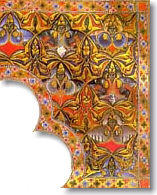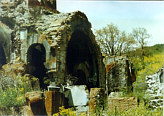Splintering Unity
Mongols, Orbelians and Proshians
Tour Armenia
IVERIA THE MONGOLS A SECOND FLOWERING
Iveria & the Bagratunis
In the East, Bagrat III, prince over Iveria (975-1014) united the eastern and western Georgian principalities, and the rise of Georgian power, begun under King David IV 'The Builder' (1089-1125), who repulsed Arab dominance in 1122, culminated during the reign of his great granddaughter, Queen Tamara (1184-1213). Georgian rulers advanced into Armenia, liberating the kingdoms of Ani, Kars, Lori, Bjini, Siunik and Dvin. The entire northern, central and eastern regions of Armenia were now under the control of rulers of Armenian descent.
The Bagratuni family is traced at last to the 4th century BC, with a dominant rise in fortunes in the Christian era. The various arms of the family stretch over much of historic Armenia, and inter-marriage with Romans, Greeks, Persians, Zakarians, Proshians and Orbelians make it difficult to trace to a single root. And most Georgians would fight to the teeth to defend the exclusive "Georgian-ness" of Bagrat, David and Queen Tamara. With so much intermarriage, who is to say (about a thousand arm chair critics)? But what is clear is that under attack and threat of assimilation by expanding Seljuk Turks, Armenia owes its survival in this period to the Georgian kingdom, and to the expansion of the Northern and Eastern territories of Lori, Ararat and Siunik. Among Armenia's most beautiful regions, they are also endowed with stunning architectural triumphs, including the Universities/monasteries at Haghbat, Sanahin, Gladzor and Tatev. In Lori, the construction was astounding, with the expansion of the capital Lori Berd, Akhtala, Odzun, Haghbat, Sanahin, Kobair, Dsegh, Shnogh and Sedvi.
The Zakarians, commanders-in-chief of the Georgian and Armenian armies were the most powerful family, ruling over Ararat valley and Lake Sevan with their seat at Ani. Another family, the Orbelians, became overlords over Siunik. From the latter part of the 12th century until the invasion of the Mongols, Armenia was virtually independent, and flourishing.
The Mongols, Orbelians and Proshians
 While in the 13th century the Armenians prospered in the Cilician Kingdom, those living in Greater Armenia witnessed the invasion of the Mongol Tatars between 1220-36. As destructive as they were, the Mongol invasions did not seriously upset the internal situation. Both Armenia and Georgia became vassal states of the Great Khan, but were reinstated as feudal lords. Having become a part of the great Mongol Empire, Armenia benefited from the international trade, though the northern cities of Ani, Dvin and Kars no longer held the foremost positions. The southern route along the North Shore of Lake Sevan appears to have been used more often. Lands under Mongol control enjoyed religious freedom, persecutions beginning only when the Mongols were converted to Islam. While in the 13th century the Armenians prospered in the Cilician Kingdom, those living in Greater Armenia witnessed the invasion of the Mongol Tatars between 1220-36. As destructive as they were, the Mongol invasions did not seriously upset the internal situation. Both Armenia and Georgia became vassal states of the Great Khan, but were reinstated as feudal lords. Having become a part of the great Mongol Empire, Armenia benefited from the international trade, though the northern cities of Ani, Dvin and Kars no longer held the foremost positions. The southern route along the North Shore of Lake Sevan appears to have been used more often. Lands under Mongol control enjoyed religious freedom, persecutions beginning only when the Mongols were converted to Islam.
Several Armenian princes were present at the election of Guyak as Grand Khan in 1246 AD. The historian Vardan visited the Mongol court several times, while another historian Stephen Orbelian, archbishop of Siunik, witnesses the christening of Khan Arghun's son, and he was asked to bless the chapel sent by the pope. Armenians, familiar with the eastern languages, often acted as interpreters. The alliance between the Mongols and the Armenian kings of Cilicia also favored friendly relations.
The country experienced one of the greatest developments of cultural flowering during the 13th and part of the 14th centuries. Armenian culture developed to a new level of artistry in church and monastery construction and the veneration of the Madonna increased in church iconography. Throughout the entire country churches and monasteries were built to ever-greater heights and grandeur. Outstanding examples of architectural achievement include the monasteries of Hovhanavank, Saghmosavank, Sanahin-Odzun, Haghbat, Haghartsin, the mausoleum church of Noravank, the city of Yeghegis, and the Proshian cave chapel at Geghard.
A Second Flowering
 A second flowering of culture occurred in manuscript art, under the patronage of wealthy princely families and merchants enjoying a 150-year period of peace and prosperity. At the great universities at Gladzor and Tatev, thousands of manuscripts on science, philosophy and medicine were written, so advanced in their studies they describe natural and cosmic laws not accepted in Europe until the 17th century. The universities were developed centers for learning at the same time the Italian renaissance was beginning, and roughly 200 years before the renaissance in Northern Europe. A second flowering of culture occurred in manuscript art, under the patronage of wealthy princely families and merchants enjoying a 150-year period of peace and prosperity. At the great universities at Gladzor and Tatev, thousands of manuscripts on science, philosophy and medicine were written, so advanced in their studies they describe natural and cosmic laws not accepted in Europe until the 17th century. The universities were developed centers for learning at the same time the Italian renaissance was beginning, and roughly 200 years before the renaissance in Northern Europe.
What is unique about Armenia’s development in the sciences is it’s apparent lack of repression by religious doctrine. The Dark Ages that swept through Europe in the early middle ages were a period of great advancement in Armenia, and the tradition of exploring the universe was always protected and encouraged by the church. As invasion after invasion swept over the country, the church was depended on to preserve not only the Christian belief, but also the identity of the culture itself. Manuscripts reveal an astounding body of knowledge on astronomy, medicine, herbal treatments that are still effectively used to this day, mathematics and philosophy. It was seemed no less a spiritual duty to understand the nature of the universe as it was to pray.
Khachkar art was also renewed, with more elaborate and realistic depictions of the crucifixion above the central cross, and with masterpieces created throughout the country. Many Khachkar masters were also famous architects who designed cathedrals, among them perhaps the most famous is Momik, Armenia’s “Michaelangelo,” a miniaturist, architect and sculptor who worked in Vayots Dzor during 1282-1321 AD. His Khachkars can still be found at Echmiadzin and the Amaghiu Noravank, near Areni.
The Khachkars in Goshavank (1291 AD), by the master Poghos, as well as that in the yard of Geghard monastery (1213 AD), by the masters Dimot and Mkhitar, are recognized as masterpieces, as is the work of Vahram, the creator of the Khachkars of Haghbat and the Amenaprekich of Dsegh, who gave new form and content to their design.
Despite these contacts, Armenian princes were not able to check the increasingly repressive measures of Mongol chieftains. Having to take part in Mongol wars, Armenia was deprived of many of its able-bodied men, and as the Mongol power weakened, nomadic tribes, particularly the Turkmen, penetrated in larger numbers into the country. The revival was broken by the invasion by Timur (Tamerlane) at the end of the 14th c.
Division of Greater Armenia
 The 15th century is marked by decline and decay. The great cultural achievements of the previous century and a half were never to be reproduced, as wave after wave of Turkmen tribes invaded the Armenian lands. The struggle over Armenia and the Caucasus between the Persian Safavid dynasty, who invaded in the 16th century, and the Ottoman Turks, who had taken Constantinople in 1453 was resolved in 1514-1516, when the Ottomans took over most of Armenia. In 1578 they overran the rest of the Caucasus but were driven from Azerbaijan, Tbilisi, Yerevan Nakhichevan and Karabakh by the Safavid Shah Abbas I (1587-1629). The 15th century is marked by decline and decay. The great cultural achievements of the previous century and a half were never to be reproduced, as wave after wave of Turkmen tribes invaded the Armenian lands. The struggle over Armenia and the Caucasus between the Persian Safavid dynasty, who invaded in the 16th century, and the Ottoman Turks, who had taken Constantinople in 1453 was resolved in 1514-1516, when the Ottomans took over most of Armenia. In 1578 they overran the rest of the Caucasus but were driven from Azerbaijan, Tbilisi, Yerevan Nakhichevan and Karabakh by the Safavid Shah Abbas I (1587-1629).
 With the annexation of the Armenian plateau, the Armenians lost all vestige of an independent political life for the next 330 years. The Persian leader Shah Abbas I inaugurated a policy of moving entire populations of Armenians to his country to create a deserted land in the path of an Ottoman advance, as well as bringing a skilled merchant and artisan class to his new capital, Isfahan. The Armenian community of New Julfa, a suburb of Isfahan, was held in great esteem by the Shah and became one of the economic bases for the Safavid State. With the annexation of the Armenian plateau, the Armenians lost all vestige of an independent political life for the next 330 years. The Persian leader Shah Abbas I inaugurated a policy of moving entire populations of Armenians to his country to create a deserted land in the path of an Ottoman advance, as well as bringing a skilled merchant and artisan class to his new capital, Isfahan. The Armenian community of New Julfa, a suburb of Isfahan, was held in great esteem by the Shah and became one of the economic bases for the Safavid State.
Persians ruled Eastern Armenia until 1828, when Russia annexed it. The Safavid dynasty ended in 1722, and the Ottomans invaded again, into Georgia. This time they were expelled by the Persian Nader Shah, who put the Bagratids in power in the central princedom of Kartalinia. The Bagratid Irakli II united his princedom with Kakheti, and tried to form a multinational Caucasus state.
One of the side stories of this period, and a source of romantic legend is the tale of the Armenian hero David Bek and Princess Tamara. Bek lived in Tbilisi, and feel in love with the princess. Because he was not royalty, he was banished from the court, and made his way to Siunik, where he led resistance against Turkish and Persian armies. He fortified the fortress at Baghaberd, and reopened the single road through the Voghji River valley so that the population could bring food and supplies in. His small group was impregnable in Baghaberd, and he turned the tide of the war in Siunik by surprising Turks trying to invade through a mountainous pass with a small band, slaughtering them in a canyon.


 Top
Top

|
